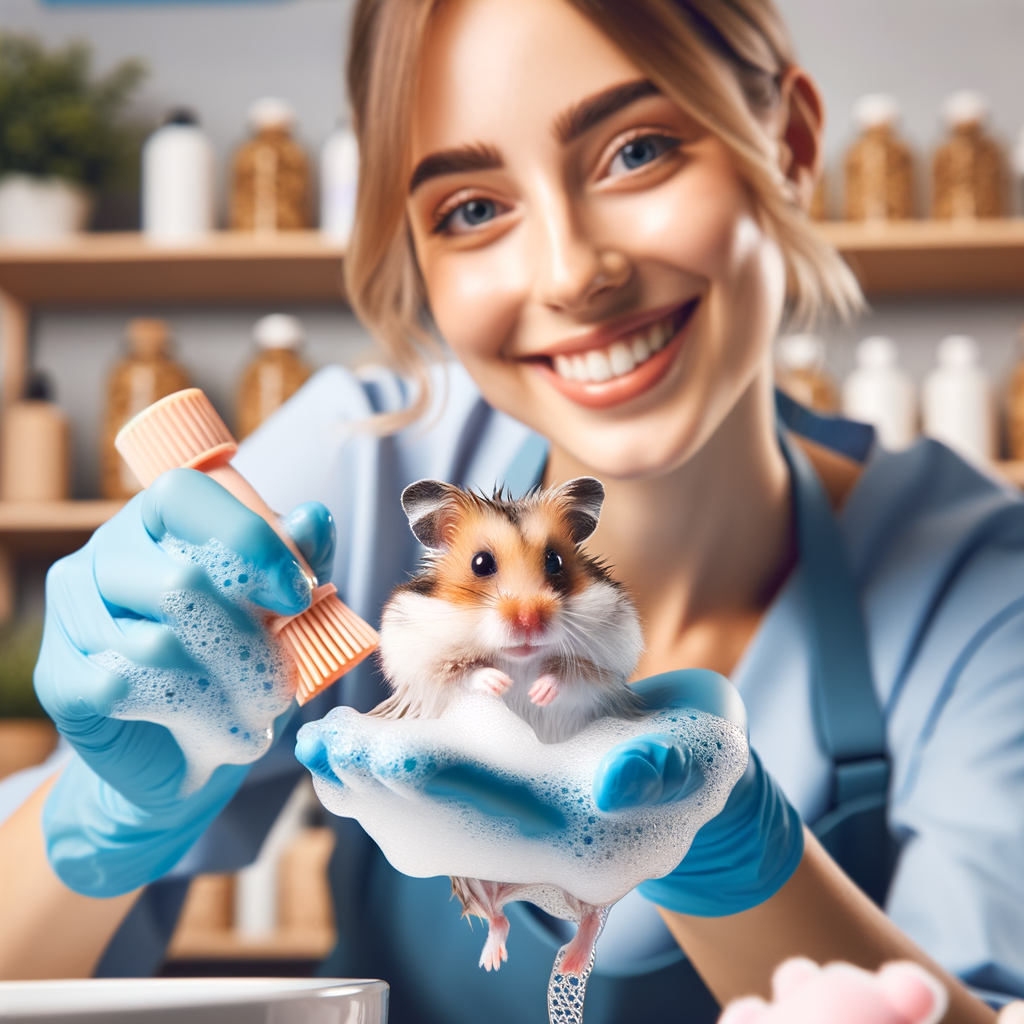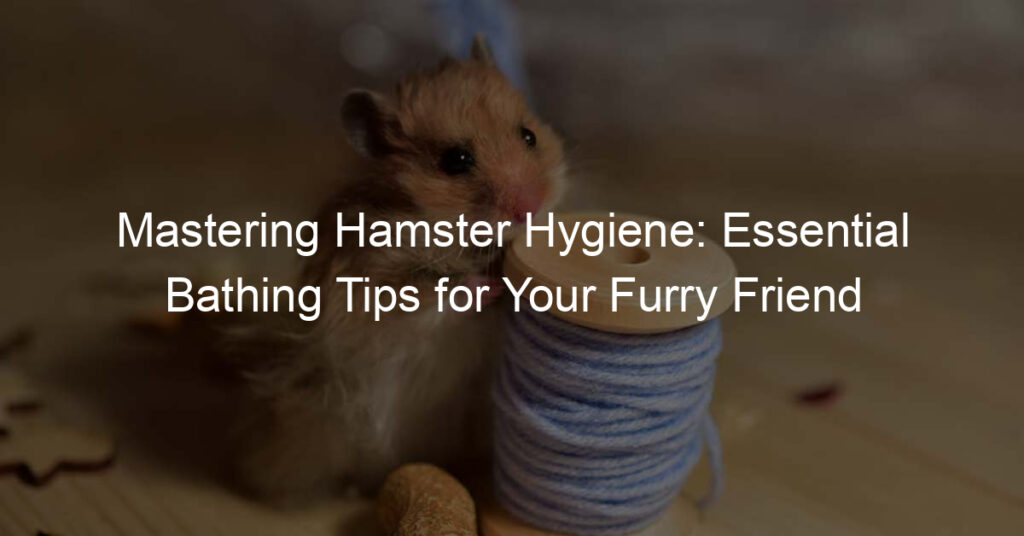
Introduction to Hamster Hygiene
Hamsters are adorable, fun, and low-maintenance pets, making them a popular choice for kids and adults alike. However, just like any other pet, they require proper care and hygiene to stay healthy and happy. This blog post will introduce you to the importance of hamster hygiene and the basics of keeping your pet hamster clean.
- Importance of Pet Hamster Care
- Understanding the Basics of Hamster Cleanliness
Hamsters, despite their small size, need a clean environment to thrive. A dirty cage can lead to various health issues like skin infections, respiratory problems, and even stress. Regular cleaning and grooming of your hamster can help prevent these issues and ensure your pet’s longevity. It’s not just about keeping your hamster looking cute; it’s about keeping them healthy and comfortable.
Hamster cleanliness involves two main aspects: cleaning the hamster itself and cleaning its living environment. Hamsters are generally clean animals and spend a significant amount of their time grooming themselves. However, they still need your help to keep their cage clean. Regularly removing old food, soiled bedding, and waste can help maintain a clean and odor-free environment for your hamster. Additionally, providing a sand bath for your hamster can help them keep their fur clean and soft.
In the following sections, we will delve deeper into the specifics of hamster care and hygiene, including a step-by-step guide on how to bathe your hamster and tips on keeping your hamster clean without bathing. So, stay tuned and let’s embark on this journey of learning how to keep our furry friends fresh and clean!
Hamster Care Basics
When it comes to keeping your hamster happy and healthy, understanding their basic needs is crucial. This includes knowing how to keep them clean and the importance of regular grooming.
Understanding Your Hamster’s Needs
Hamsters are small creatures with big needs. They require a clean environment and regular grooming to stay healthy. Let’s delve into these two essential aspects of hamster care.
- How to Keep Hamsters Clean
- Importance of Regular Grooming
Keeping your hamster clean is not as complicated as it might seem. Hamsters are naturally clean animals and spend a significant amount of their time grooming themselves. However, they still need your help to maintain a clean living environment. This includes regularly cleaning their cage, replacing their bedding, and removing any uneaten food or waste. Remember, a clean cage means a happy and healthy hamster.
Regular grooming is another essential aspect of hamster care. While hamsters do a good job of grooming themselves, they can sometimes miss spots or struggle with certain areas, especially as they get older. Regularly brushing your hamster can help remove loose fur and prevent matting. Plus, it’s a great way to bond with your furry friend. Just be gentle and use a soft-bristle brush suitable for small animals.
In conclusion, understanding your hamster’s needs and providing proper care is key to their health and happiness. Remember, a clean and well-groomed hamster is a happy hamster.
Hamster Grooming Tips
Keeping your hamster clean and well-groomed is an essential part of their care. Here are some tips to help you with this task:
- Choosing the Right Grooming Tools
- Hamster brush: A small, soft-bristled brush is perfect for gently brushing your hamster’s fur. This helps to remove any loose fur and keep their coat looking shiny and healthy.
- Nail clippers: Hamsters’ nails can become overgrown if not regularly trimmed. Use a pair of baby nail clippers for this task. Be careful not to cut too close to the quick, as this can cause pain and bleeding.
- Chew toys: Chew toys help to keep your hamster’s teeth in good shape. They wear down the teeth, preventing overgrowth.
- Establishing a Grooming Routine
Just like humans, hamsters also need the right tools for grooming. Here are some items you should consider:
Establishing a regular grooming routine is crucial for your hamster’s health and well-being. Here’s a simple routine you can follow:
| Activity | Frequency |
|---|---|
| Brushing | Once a week |
| Nail trimming | Once a month |
| Teeth check | Once a week |
Remember, every hamster is unique and may require a different grooming schedule. Always observe your hamster and adjust the routine as necessary.
Bathing a Hamster: Step-by-Step Guide
Keeping your hamster clean is an essential part of pet care. This guide will walk you through the process of bathing your hamster safely and effectively.
Preparation for Bathing
Before you start the bathing process, there are a couple of important steps to take to ensure a smooth and stress-free experience for both you and your hamster.
- Choosing the Right Time
- Gathering Necessary Supplies
Hamsters are nocturnal creatures, meaning they are most active during the night. It’s best to bathe your hamster during their active hours to reduce stress. However, make sure they are not in the middle of eating or exercising, as this could cause unnecessary stress.
Before you begin, gather all the supplies you’ll need. This includes a small, shallow container for bathing, a towel for drying, pet-friendly shampoo, and a soft brush or cloth for cleaning. Having everything prepared beforehand will make the process easier and less stressful for your hamster.
Remember, bathing should be a rare occurrence for hamsters as it can strip their fur of essential oils. Always consult with a vet or a hamster care expert before deciding to bathe your hamster.
How to Bathe a Hamster
Bathing a hamster is a delicate process that requires careful handling and specific steps. Follow this step-by-step guide to ensure your hamster stays clean and healthy.
- Step 1: Gently Wet Your Hamster
Start by gently wetting your hamster. Use a small, soft cloth or sponge and lukewarm water. Avoid getting water in your hamster’s eyes, ears, and nose as it can cause discomfort or even health issues. Remember, hamsters are small creatures, so be gentle and patient.
- Step 2: Apply Pet-Friendly Shampoo
Once your hamster is wet, apply a small amount of pet-friendly shampoo. Avoid using human shampoo as it can be harmful to your hamster’s skin. Gently massage the shampoo into your hamster’s fur, taking care to avoid the face and genital areas.
- Step 3: Rinse Thoroughly
After applying the shampoo, it’s time to rinse your hamster. Use lukewarm water and ensure that all the shampoo is removed from the fur. Any residue can irritate your hamster’s skin, so make sure to rinse thoroughly.
- Step 4: Dry Your Hamster
Finally, gently dry your hamster using a soft, absorbent towel. Be sure not to rub too hard as this can cause discomfort. Once your hamster is mostly dry, you can let it finish drying naturally in a warm, draft-free area. Never use a hairdryer as this can be too hot and stressful for your hamster.
Remember, bathing your hamster should be done sparingly as it can strip the natural oils from their fur. Always monitor your hamster during and after the bath to ensure they are comfortable and healthy.
Keeping Hamsters Clean Without Bathing
While it’s important to keep your hamster clean, bathing them in water can be stressful and even harmful. But don’t worry, there are other ways to keep your furry friend fresh and clean. Let’s explore some grooming tips that can help maintain your hamster’s hygiene without the need for a bath.
Hamster Grooming Tips
Grooming your hamster regularly can help keep them clean and healthy. Here are some tips to help you with this task:
- Brushing Your Hamster’s Fur
- Cleaning Your Hamster’s Ears
Brushing your hamster’s fur not only helps keep it clean but also promotes blood circulation. Use a soft-bristled toothbrush or a small animal brush for this task. Remember to be gentle and only brush in the direction of the fur growth. This should be done once a week or more frequently for long-haired breeds.
Hamsters can get dirt and wax build-up in their ears, just like humans. To clean your hamster’s ears, use a cotton swab dipped in warm water. Be very careful not to insert the swab into the ear canal. Instead, gently clean the outer part of the ear. This should be done once a month or whenever you notice a build-up.
Remember, grooming is a bonding time between you and your hamster. Always be gentle and patient. If your hamster seems uncomfortable or stressed, give them a break and try again later.
Keeping the Cage Clean
Keeping your hamster’s cage clean is a crucial part of maintaining their health and happiness. Here are two key aspects to consider:
- Regular Cleaning Schedule
- Choosing the Right Bedding
Establishing a regular cleaning schedule is the first step towards a clean cage. It’s recommended to do a full cage clean once a week. This includes removing all bedding, washing the cage with a pet-safe cleaner, and replacing the bedding. However, spot cleaning should be done daily. This involves removing soiled bedding and replacing it with fresh bedding. By sticking to this schedule, you can ensure that your hamster’s living environment remains clean and odor-free.
Choosing the right bedding is equally important. Hamsters prefer bedding that is soft, absorbent, and dust-free. Paper-based bedding is a popular choice as it meets all these criteria. Avoid using cedar or pine shavings as these can cause respiratory issues in hamsters. The bedding should be deep enough for your hamster to burrow and nest in. A depth of 2 inches is generally recommended. Remember, the right bedding not only keeps the cage clean but also contributes to your hamster’s overall well-being.
| Cleaning Task | Frequency |
|---|---|
| Full Cage Clean | Once a week |
| Spot Cleaning | Daily |
In conclusion, keeping your hamster’s cage clean involves a regular cleaning schedule and choosing the right bedding. By adhering to these practices, you can provide a clean and comfortable home for your hamster.
Conclusion: Fresh and Clean Hamsters
As we wrap up our discussion on hamster hygiene, it’s important to remember that keeping your hamster clean is not just about making them look good. It’s about ensuring they live a healthy and happy life. Let’s recap some of the key points we’ve covered.
- Recap of Hamster Hygiene Tips
- Importance of Regular Pet Hamster Care
Firstly, remember that hamsters are naturally clean animals and do not require frequent baths. In fact, bathing them too often can strip their fur of essential oils and lead to skin problems. Instead, provide them with a sand bath for their natural grooming habits.
Secondly, keep their habitat clean. Regularly clean their cage, replace bedding, and remove any leftover food or waste. This will prevent the buildup of bacteria and keep your hamster healthy.
Lastly, monitor your hamster’s health. If you notice any changes in their behavior, fur, or overall health, it may be a sign of illness and you should consult a vet.
Regular care for your pet hamster goes beyond hygiene. It includes providing a balanced diet, enough exercise, and mental stimulation. Hamsters are active and curious animals, so provide them with toys and activities to keep them engaged.
Regular vet check-ups are also crucial to detect any potential health issues early. Remember, a clean and well-cared-for hamster is a happy hamster.
Keeping your hamster fresh and clean is a responsibility that comes with owning these adorable pets. By following the tips we’ve discussed, you can ensure your hamster stays healthy and enjoys a high quality of life. After all, a clean hamster is a happy hamster!








